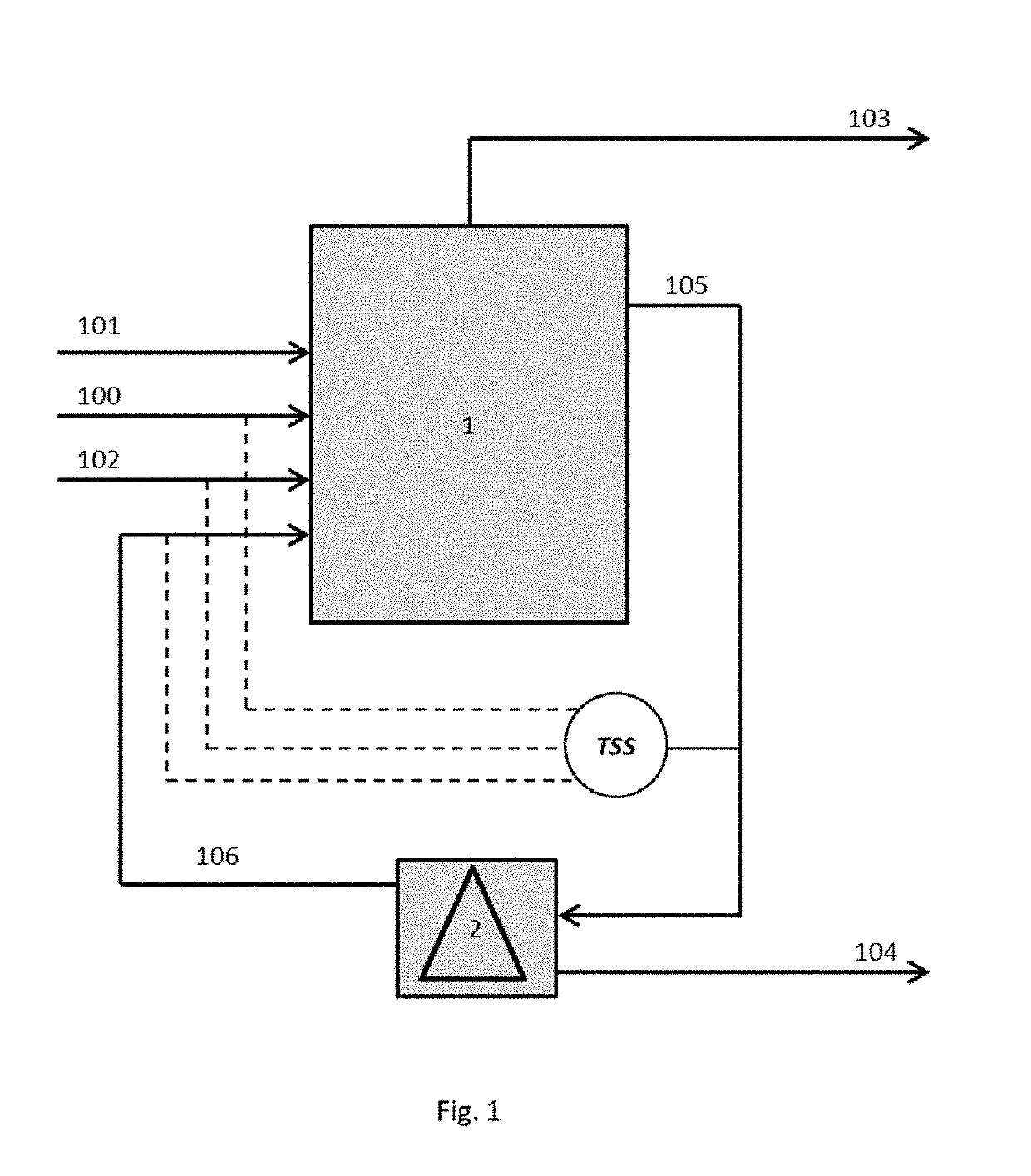Process for producing biogas from fibrous substrate
a technology of fibrous substrate and biogas, which is applied in the field of process for producing biogas from fibrous substrate, can solve the problems of increasing the difficulty of anaerobic breakdown of macromolecules of fibre constituents, hemicellulose and cellulose and lignin, and reducing stability, so as to reduce the gas yield
- Summary
- Abstract
- Description
- Claims
- Application Information
AI Technical Summary
Benefits of technology
Problems solved by technology
Method used
Image
Examples
example 1
[0052]The determination of the TSS is described in detail hereinafter.
[0053]Principle: The dry substance and the dissolved dry substance of a sample are determined by evaporating water of an undiluted sample or a diluted filtrate in a muffle furnace. The suspended dry substance (TSS) can be calculated using these values.
[0054]Material: 50 ml centrifuge tube, disposable syringe 5 ml, syringe preliminary filter 0.2 μm, analytical balance, centrifuge, Nabertherm B180 muffle furnace, refractory glass dish, desiccator, crucible tongs, distilled water.
[0055]Execution: The determinations of the dry substance and the dissolved dry substance are to be performed as double determinations. The sample to be examined is homogenised by shaking prior to its removal. For the TS determination, dishes are weighed and in each case the weight (m1) is noted. 10.00±1.0 g of the sample are filled into each dish and the end weight is likewise noted (m2). In order to determine the dissolved dry substance, 10...
example 2
[0072]A further method for determining the TSS content is described in detail hereinafter.
[0073]The TSS is determined by vacuum filtration of a defined sample quantity through a cellulose acetate filter with a pore size of 0.45 μm.
[0074]The 0.45 μm cellulose acetate filter can be prewashed with 150 ml water in order to remove the water-soluble contaminations. The filter is then dried at 105° C. for at least one hour to constant mass and stored in the desiccator until use. It should be noted that the filter is not contaminated by dust.
[0075]The filter is weighed prior to the filtration (m1) and is then placed in the funnel of a filtering unit.
[0076]The sample to be examined is homogenised by vigorous shaking, and then approximately 10 g (m2) of this sample are filled directly into a 25 ml measuring cylinder. The sample is filtered by means of vacuum, and the measuring cylinder is flushed twice with 25 ml water. The filter and the funnel are then flushed with a further 50 ml water, an...
example 3
[0080]The possibility of a technical execution of the process will be explained hereinafter on the basis of the fermentation of straw. Merely by way of example, straw represents the fibrous substrates considered in this application. The details are readily transferable by a person skilled in the art to the use of other suitable substrates.
[0081]The example makes reference to FIG. 1, in which the reference signs have the following meanings:[0082]100 straw[0083]101 nutrients / trace elements[0084]102 water[0085]103 biogas[0086]104 waste material[0087]105 output[0088]106 process liquid[0089]1 fermentation[0090]2 solid-liquid separation
[0091]Straw, as an agricultural waste material, is very well suited as a substrate for biogas recovery. However, straw contains significant amounts of substances which are difficult to breakdown and which are hardly, or not at all, broken down within economically reasonable time periods. The substrate composition can vary greatly depending on the type of st...
PUM
| Property | Measurement | Unit |
|---|---|---|
| Fraction | aaaaa | aaaaa |
| Fraction | aaaaa | aaaaa |
| Fraction | aaaaa | aaaaa |
Abstract
- a) the fibrous substrate is fed together with process liquid to a fermenter containing anaerobic microorganisms depending on the TSS content ascertained in this fermenter,
- b) the fibrous substrate is subjected to wet fermentation in this fermenter to produce biogas
- c) the output containing fermented fibrous substrate is drawn off from the fermenter and the TSS content in the fermenter is ascertained,
- d) the TSS content ascertained is compared with a fixed target range and
- e) depending on the result from d), step a) is repeated with adjusted amounts in order to comply with the target range for the TSS in the fermenter.
Description
Claims
Application Information
 Login to view more
Login to view more - R&D Engineer
- R&D Manager
- IP Professional
- Industry Leading Data Capabilities
- Powerful AI technology
- Patent DNA Extraction
Browse by: Latest US Patents, China's latest patents, Technical Efficacy Thesaurus, Application Domain, Technology Topic.
© 2024 PatSnap. All rights reserved.Legal|Privacy policy|Modern Slavery Act Transparency Statement|Sitemap

